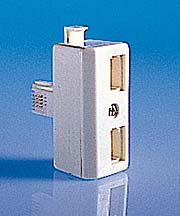Again AT&T didnt plan on DSL when they implement their ISDN system.
Your telco uses standard isdn telephone modulators, meaning, the signal from the pole to your external junction box is digital. There are modulators with ip addresses in your junction box.
Either ATT had to completely replace the ISDN standard, screwing every telco in the world, or come up with a legacy phone standard where it would be backwards compatible.
Basically, when activated, your tel-ip[ip address assigned to the telephone modulator in your junction box....this is what your telco bills...] gets extra access information written to it. Therefore, when given proper credential, it will activate the full spectrum band, and you will need a filter to have modulator recognize an outgoing/incoming call vs regular packets.
You have to have a filter on every outlet that you have a regular phone connected. You can also pickup a socket with filtered an unfiltered ports.
ATT had to half-ass this standard because the legacy telephone standard is 100 years old.
VOIP is EXACTLY the same thing, but much more simplified....
If your residence is properly connected using ATT/BELL standard. Then you have a star configuration vs a series configuration. Meaning, every telephone socket is separately connected to a central junction board. If its connected in series, as in, the wires are connected from socket to socket in series, then are are getting degraded voice quality and even packet loss resulting in a slow dsl connection which drops off regularly.
If your residence is properly wired toward the ATT/BELL standard, then you can just insert a single filter at your junction board....therefore, your residence will have dedicated dsl socket, and all the other phone sockets would be pre-filtered from the filter on junctionboard.
Generally, junctionboards come after telco junction boxes and amps....
These junction boards also allow you to easilty dedicate a different phone number to a different socket....



